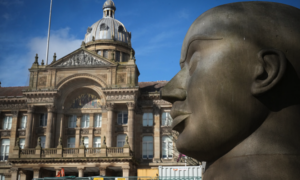Almost exactly 60 years ago, the Duke of Gloucester launched a new world. There, amid the artificial lighting, and the multi-storey carpark, he unveiled Broad Marsh — a £10 million shopping and entertainment complex right in the middle of Nottingham. The local council promised the centre would “completely transform” this corner of town, just south of the city heart, and it’s hard to disagree. Gone went a warren of ancient lanes, with its medieval ruins and Victorian garrets. In their place came a bland brick structure, with coloured tiling, and fountains, and wooden play animals for children to play on.
Now, though, Broad Marsh is dead, with Nottingham City Council this month expected to finalise plans to complete the centre’s demolition — paving the way for a vast redevelopment scheme for 1,000 homes and 20,000 square feet of new retail, office space and entertainment. It will, as you may have guessed, completely transform the area.
To those familiar with Nottingham, this will surely be welcome news: the shopping centre closed in 2020 during extensive renovation works. For the past five years, locals have had to meander through a half-demolished site, through makeshift walkways and past mounds of rubble, to get from the train station to the city centre. Behind a bright green hoarding sits what’s left of Broad Marsh, an unsubtle metaphor for the 20th century consumer dream laid waste. Yet more than the mistakes of the past, Nottingham’s story has future lessons too — not least on the dangers of private investors, and how towns don’t even need mass retail to thrive in the 21st century.
In many ways, the Broad Marsh story is unremarkable, both in its rise and fall. Around 300 shopping centres opened in Britain between the mid-Sixties and the mid-Seventies, while over 250 have closed, been demolished or are scheduled for redevelopment. There’s no shortage of ailing precincts, and 2025 is set to be a busy year for the wrecking ball. The Core in Leeds; the St Nicholas Centre in Sutton; Slough’s Queensmere — these are just three demolition schemes among many.
The future of Broad Marsh has been hanging in the balance since the mall’s operator, intu (the lower-case “i” is trendily deliberate), went into administration during the first Covid lockdown. But the saga stretches back decades, with unrealised renovation plans dating back to the millennium. To many, indeed, it has become little more than a mark of urban blight. In 2020, a city-wide consultation found that more than two thirds of residents and businesses would prefer green open space, and premises for hospitality and the community — while retail polled poorly by comparison.
Things weren’t always so depressing. As that royal opening so tantalisingly hints, shopping precincts were once all the rage, as local authorities hoped to revitalise declining town centres, many of which had been crumbling since the war or even earlier. Several factors contributed to this boom — not least planning recommendations to alleviate and anticipate growing car traffic in urban cores.
Private property companies were crucial to the financing and delivery of new shopping centres. With a government ban on out-of-town developments, owing to concerns for the viability of the British high street, as well as limits on commercial office development in London, provincial towns across Britain suddenly became appealing investments.
In Nottingham, the Broad Marsh area had long been earmarked for redevelopment, with plans to build a bus station on land majority-owned by the council. The impetus to do so came from an offer of a partnership with Town and City Properties, a company better known by the name of its shopping centres: Arndale. It was, on paper, an excellent offer. The council would get its bus station, and the city would secure a modern shopping complex inspired by the latest international malls.
The developer, in turn, would secure a lucrative cash cow, as Arndale Centres were simultaneously constructed from Bradford to Bolton to Nelson. Like at Nottingham, all these examples are currently awaiting demolition. And, as at Broad Marsh, they tended to offer drab architectural fare, their enclosed pedestrian malls a spaceship-like presence in the wider city.
Partly for this reason — and notwithstanding the enthusiasts in local government — there was vocal public opposition to such developments right from the start. That’s especially when the plans typically came with threats to demolish historic sites. Beyond the remains of a medieval abbey, the Broad Marsh redevelopment also included the demolition of Drury Hill, a public highway dating back to the 14th century. Other objections focused on access to space: some in Nottingham felt the shopping centre’s location could be shifted to leave space for a park.
In Nottingham, as elsewhere, several public inquiries were held into the redevelopment of Broad Marsh. Yet the strength of local feeling was ultimately ignored. What good, wondered the powers-that-be, was a rundown, centuries-old passageway, when it could be replaced with something modern and weatherproof?
By the mid-Seventies, then, British cities had been transformed. Yet though they offered a cash bonanza for councils and developers alike, this private-public arrangement soon proved something of a Faustian pact. Access to previously public highways was now policed by private firms, gleefully funnelling pedestrians through covered malls. High rents in shopping centres also excluded small businesses from competing with chain stores for space. All this amounted to the colonisation of central Nottingham, and the alienation of local people and local enterprise, especially as property takeovers in the late-20th century meant mall operators consisted of an increasingly small cohort of global real estate firms.
No wonder Nottingham boasted the lowest retail occupancy rates in the country by 2011, an oversaturation made worse by the development of a second shopping area, the Victoria Centre, just a 10-minute stroll to the north. As those stark closure numbers imply, meanwhile, these problems are far from unique to the East Midlands. Britain’s retail sector never fully recovered from the 2008 recession, while shopping habits have substantially shifted in recent years, a move only exacerbated by the pandemic. For their part, many shopping centre operators have adapted by converting shops into leisure space in anticipation of a more experiential economy. Think cinemas, restaurants and bowling alleys: this had been the general thrust of intu’s botched remodelling. Crazy golf is another popular choice.
Following intu’s collapse, in 2020, Nottingham City Council took the Broad Marsh site back into full public ownership. Later that year, it launched a city-wide public consultation into the future of the area, with the findings reimagined in a scheme by Thomas Heatherwick, the designer provocateur responsible for the redevelopment of Coal Drops Yard in Kings Cross (and the failed Garden Bridge project). Alongside housing and commercial space, the key idea was to reestablish the area’s lost medieval throughways. Heatherwick mooted a green space too, while also suggesting that the centre’s dismantled concrete and steel frame could be used for public events.
In short, then, Heatherwick’s scheme suggested that a better future could emerge from the ruins of failed 20th consumption. And, certainly, there is a clear precedent for this approach. In 2019, for instance, Stockton-on-Tees council purchased a redundant Seventies shopping centre — which it has demolished for the creation of a new public park, part-financed by the Government’s now-ended Future High Streets Fund.
In Nottingham, though, the Broad Marsh redevelopment has made slow progress. On three occasions, the council failed to secure Levelling Up funds (remember that?) to finance further demolition. Last May, the architecture firm BDP unveiled its masterplan for the area, in response to Heatherwick’s vision, and in September the “Green Heart” park finally opened. Even so, much of the area remains a building site. Just as bad, and echoing the errors of earlier decades, the Broad Marsh plans are now being adapted in the hopes of securing private investment, with a question mark hanging over keeping that ambitious steel frame — sparked by hesitancy from investors and developers over its viability.
Whatever comes next must be scrutinised — particularly given the poor decisions of the past. At the height of that mid-century boom, it was not uncommon for municipal amenities to be dropped from final planning schemes, as indeed happened with an undelivered batch of houses at Broad Marsh. With the financial burden of intu’s disastrous departure weighing heavy on the council’s books, any redevelopment in Nottingham clearly needs to pay. But if the past 60 years have shown anything, it’s that the shopping centre is no longer (if it ever was) at the forefront of rejuvenating Britain’s urban cores. For this reason, we should be sceptical of anyone claiming that redevelopment needs yet more retail space.
Housing, indeed, is emerging as one of the clearest alternative uses for shopping centres, especially as one way of meeting Labour’s agenda for 1.5 million new homes. But that, too, must come with caveats. In 2020, housing activist Bob Colenutt wrote of a “finance-housebuilding complex” and described it as a root cause of Britain’s ongoing housing crisis. Among other things, he noted that developers are not obliged to follow through on ancillary amenities — health centres, bus stops — once construction is under way. At the same time, recent research suggests that 75% of new housing developments are mediocre or poor, while the majority of Build to Rent developments are operated by foreign private investment funds. It all sounds remarkably like the partnerships that local authorities found themselves entangled in six decades ago.
Though, in short, it makes sense for housing to be high up the agenda for the Broad Marsh redevelopment, there is also an opportunity for the council to be bold. With the area back in public ownership — as is the case with many derelict shopping centres across Britain — the council should insist on a robust, beautiful vision for Nottingham’s new urban quarter. In practice, that means reinvesting in public spaces and local enterprise, from well-designed pedestrian walkways to rent-capped commercial units for local business. For my part, I’d like to see planners retain a small section of Broad Marsh’s broken frame, as a reminder of global capital’s fickle promise of urban utopia.
Disclaimer
Some of the posts we share are controversial and we do not necessarily agree with them in the whole extend. Sometimes we agree with the content or part of it but we do not agree with the narration or language. Nevertheless we find them somehow interesting, valuable and/or informative or we share them, because we strongly believe in freedom of speech, free press and journalism. We strongly encourage you to have a critical approach to all the content, do your own research and analysis to build your own opinion.
We would be glad to have your feedback.
Source: UnHerd Read the original article here: https://unherd.com/




